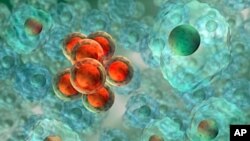An international team of scientists at a U.S. university is investigating whether 'cooking' cancerous tumors — using tiny nanoparticles in a magnetic field — might be an effective and useful treatment. Preliminary findings suggest they may be on the right path.
Using heat to kill living cells isn't new. The challenge in using the idea medically is to kill off the cancer cells while avoiding damage to nearby healthy tissue.
Professor Ishwar Puri of Virginia Tech uses a kitchen analogy to explain the challenge.
"As everyone who tries to heat up water in a pot knows, that when you heat up the pot, you also heat up the water," he says. "So if you heat one tissue, the challenge is then that you will then heat up the surrounding tissue as well. And there are ways to overcome this challenge."
In search of those ways, researchers have tried using probes inserted into the tumor, or using microwaves, like a microwave oven. But Puri says those approaches aren't selective enough. "The way that we approach it is that we load up diseased tissue with magnetic nanoparticles."
There are ways to get these minute particles into the tumors, but not into the surrounding tissue. This creates two zones, "one which will respond to a magnetic field, and another which will not."
"There is a law of physics which said that if you put a certain kind of magnetic field onto magnetic particles you will heat them up," says Puri. "So when you have these two zones, you can now heat one zone without heating up the other."
In theory, then, the heat generated by the nanoparticles kills the cancer cells, while not affecting nearby healthy tissue.
In a presentation at the American Physical Society meeting near Los Angeles on Nov. 23 and in two recent journal articles, Puri's team describes the mathematical and experimental efforts they are making to determine the best materials to use for the nanoparticles, and identify exactly how small they should be — probably around 10 nanometers, or 10 billionths of a meter.
Puri's team includes researchers in India at Jadavpur University, in Kolkata and a graduate student from Thailand.
If successful, Puri said the treatment would be most appropriate for certain types of accessible tumors, such as brain, breast and prostate cancer.
He adds that it may still be seven to 10 years before this kind of heat treatment is approved as a mainstream cancer therapy following successful animal and human testing. According to Puri, it would likely be used by doctors alongside existing treatments, including surgery, radiation, and chemotherapy.









